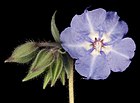Note: This is a project under development. The articles on this wiki are just being initiated and broadly incomplete. You can Help creating new pages.
Trichodesma zeylanicum
Trichodesma zeylanicum is usually an annual plant, but can become perennial and somewhat shrubby. The much-branched stems are usually woody, at least at the base, and grow up to 150cm tall from a taproot. The plant is sometimes harvested from the wild as a local source of food and medicines. The seed oil/flower essence is traded on the international market under the name of ‘wild borage oil’. The main producer is Australia and the main market is western Europe. Quantities and value of the trade are unknown.
Contents
- 1 Uses
- 2 Parts Used
- 3 Chemical Composition
- 4 Common names
- 5 Properties
- 6 Habit
- 7 Identification
- 8 List of Ayurvedic medicine in which the herb is used
- 9 Where to get the saplings
- 10 Mode of Propagation
- 11 How to plant/cultivate
- 12 Commonly seen growing in areas
- 13 Photo Gallery
- 14 References
- 15 External Links
Uses
Tuberculosis, Stomach-ache, Diarrhoea, Snakebite, Wounds, Boils, Fevers, Dysentery, Coughs, Scabies.[1]
Parts Used
Chemical Composition
Trichodesma zeylanicum contains phenolics, alkaloids, saponins, flavonoids and tannins.[2]
Common names
| Language | Common name |
|---|---|
| Kannada | Ethina naalige gida |
| Hindi | Dhadhona, Hetemuria |
| Malayalam | |
| Tamil | Kalutaikkali |
| Telugu | Pedda gurragutti |
| Marathi | Jalashirasi |
| Gujarathi | |
| Punjabi | |
| Kashmiri | |
| Sanskrit | Ambusirishika |
| English | Camel Bush, Cattle Bush |
Properties
Reference: Dravya - Substance, Rasa - Taste, Guna - Qualities, Veerya - Potency, Vipaka - Post-digesion effect, Karma - Pharmacological activity, Prabhava - Therepeutics.
Dravya
Rasa
Guna
Veerya
Vipaka
Karma
Prabhava
Habit
Identification
Leaf
| Kind | Shape | Feature |
|---|---|---|
| Leaf blades vary in size | 3.5-10.5 x 0.7x2cm but always bear white scabrous hairs on both the upper and surfaces |
Flower
| Type | Size | Color and composition | Stamen | More information |
|---|---|---|---|---|
| Cylx | White | Flowering season is January-July |
Fruit
| Type | Size | Mass | Appearance | Seeds | More information |
|---|---|---|---|---|---|
| Nutlets | 3-4mm long | Enclosed in the persistent calyx lobes, Fruiting season is January-July |
Other features
List of Ayurvedic medicine in which the herb is used
Where to get the saplings
Mode of Propagation
How to plant/cultivate
The plant is often a troublesome weed in farms. It has been recorded as an invasive species in Fiji.[5]
Commonly seen growing in areas
Disturbed dry bushland, Grasslands, Cultivated areas.
Photo Gallery
References
- ↑ Indian Medicinal Plants by C.P.Khare
- ↑ Chemical constituents
- ↑ Karnataka Medicinal Plants Volume - 2 by Dr.M. R. Gurudeva, Page No. 241
- ↑ Kappatagudda - A Repertoire of Medicianal Plants of Gadag by Yashpal Kshirasagar and Sonal Vrishni, Page No. 376
- ↑ Cultivation
External Links
- Ayurvedic Herbs known to be helpful to treat Tuberculosis
- Ayurvedic Herbs known to be helpful to treat Stomach-ache
- Ayurvedic Herbs known to be helpful to treat Diarrhoea
- Ayurvedic Herbs known to be helpful to treat Snakebite
- Ayurvedic Herbs known to be helpful to treat Wounds
- Ayurvedic Herbs known to be helpful to treat Boils
- Ayurvedic Herbs known to be helpful to treat Fevers
- Ayurvedic Herbs known to be helpful to treat Dysentery
- Ayurvedic Herbs known to be helpful to treat Coughs
- Ayurvedic Herbs known to be helpful to treat Scabies
- Herbs with Leaves used in medicine
- Herbs with Roots used in medicine
- Herbs with common name in Kannada
- Herbs with common name in Hindi
- Herbs with common name in Tamil
- Herbs with common name in Telugu
- Herbs with common name in Marathi
- Herbs with common name in Sanskrit
- Herbs with common name in English
- Habit - Perennial
- Index of Plants which can be propagated by Seeds
- Herbs that are commonly seen in the region of Disturbed dry bushland
- Herbs that are commonly seen in the region of Grasslands
- Herbs that are commonly seen in the region of Cultivated areas
- Herbs





